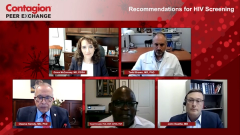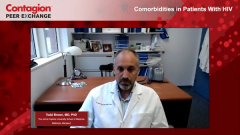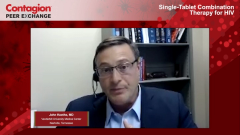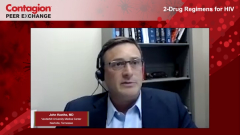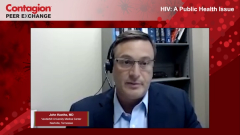
Comorbidities in Patients With HIV
Todd Brown, MD, PhD, of The Johns Hopkins University School of Medicine, recommends best practices for monitoring and managing patients with HIV for comorbid conditions.
Episodes in this series

Grace McComsey, MD, FIDSA: Let me bring in one of our 2 endocrinologists. There’s a reason we have 2 endocrinologists. We are seeing a lot of endocrine-related issues in our patients with HIV. Todd, as someone who’s experienced in dealing with comorbid conditions in HIV, do you want to talk a little about what we’re dealing with in terms of comorbidities in the clinic these days with patients with HIV?
Todd Brown, MD, PhD: Thank you for the question. It’s important; as John mentioned, the HIV population is aging. With normal aging, you get an increase in comorbid diseases and clinical events. What we’re seeing in people with HIV is that some of these comorbidities occur at an earlier age, compared to the general population. It becomes important to identify these comorbidities; dealing with comorbidities first starts with identifying the comorbidities. This comes from providers doing appropriate screening tests and education efforts to have patients know which tests they should get and when, and which comorbid diseases should be screened for. And if they’re not being screened for it, to advocate for themselves and say, “Hey, why didn’t I get a fasting glucose test to see if I have potential diabetes?” The screening is critical.
Some of the burden of comorbidities in people with HIV has to do with legacy effects of previous antiretrovirals. As we know, some of the medications that were very effective at treating HIV that were used 15 or 20 years ago can have persistent effects. I think of drugs like stavudine, or d4T, where there’s a lot of fat wasting or lipoatrophy, and those effects persist even years after people are taken off those drugs. Then of course there are effects of medications that patients are currently on, and we’ll be talking a little more about weight gain in the later segments. It’s important to think about the medications, and then thinking about effects of HIV, per se, that we know that even well-treated HIV results in increased systemic inflammation, which is likely a driver of many of these comorbidities.
We have this confluence of inflammation related to HIV and inflammation related to aging, which is important in these aging-related comorbidities. One important point regarding aging, I generally take the long view of these comorbidities, because you can screen for these comorbidities and you can find them, and you can treat them and prevent them, or treat them early and get them under control in a disease like hypertension or diabetes. But more importantly, the goal here is to prevent events. And over the long term, you think about a patient who’s middle aged, or thinking about a time horizon of say 30 years or so, you’re trying to prevent events so the person can age well, so they can maintain their physical function, their cognitive function, their quality of life. What we know is that these events that happen, whether it be myocardial infarction or a stroke or a fracture, these can have major effects on these trajectories. Trying to be proactive and prevent these events is critical in the overall aging process.
Grace McComsey, MD, FIDSA: Thank you for watching this ContagionLive® Peer Exchange. If you enjoyed the content, please subscribe to the e-newsletter so you can receive upcoming Peer Exchanges and other great content. Thank you for listening.
Transcript Edited for Clarity
Newsletter
Stay ahead of emerging infectious disease threats with expert insights and breaking research. Subscribe now to get updates delivered straight to your inbox.

